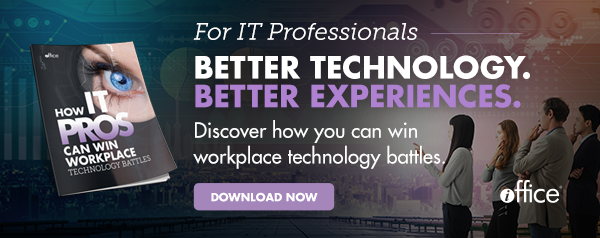Future-proof Your Workplace: 5 Priorities For IT Pros


Change is the only constant in life, and your organization’s ability to adapt to it will ultimately determine your success or failure.
Will you be a Blockbuster or a Netflix?
That may seem like a dramatic example, but the threat of becoming obsolete has never been more real.
As the gatekeeper for your organization’s nerve center, your IT department plays a critical role in future-proofing the workplace. Our friends at JLL put together a definitive guide to future-proofing everything from your facilities to your workplace technology.
Here, we’ll turn our attention to technology and what specific steps IT professionals can take to ensure your organization is ready to face whatever comes next.
1. Identify Likely Disruptors And The Impact on Future Needs
What are the biggest disruptors likely to your workplace? The first one to come to mind might be the Internet of Things. By 2020, more than 20 billion devices will be connected to the Internet (accounting for almost half of all Internet traffic) as smartphones, sensors and wearable technology becomes even more ubiquitous. Employees are becoming more accustomed to working on multiple devices and from various locations, yet many workplaces still have outdated servers and software systems that make it difficult for them to do so.
2. Review Your Technology Platforms
Given these looming disruptors, forward-thinking IT professionals need to consider how to make workplace technology more accessible for employees across devices and platforms.
If your organization hasn’t already made the move to cloud-based technology, you can’t afford to wait any longer. Compared to hosted or on-premise solutions, SaaS-based workplace technology is far more cost-effective and easier to implement and update. This makes it easier for your organization to adapt to change quickly.
3. Review Your Data Storage Needs
Just as your technology platforms need to be flexible and scalable, so does your data storage.
Considering the mind-blowing fact that 90 percent of the world’s data has been created in the past two years alone, many organizations are struggling to keep up with exponentially increasing storage demands. That’s why more are adopting hybrid and multi-cloud-based storage solutions.
Relocating your data to the cloud does come at a cost initially, but it significantly reduces the total cost of ownership over time compared to investing in expensive new data centers or buying more storage space.
One study found an ecommerce organization reduced TCO by 37 percent within three years of adopting a cloud-based storage solution.
4. Define Your Data Strategy
With sensors and smart systems collecting data on everything from occupancy to energy usage, your organization needs a game plan for managing and analyzing all this information. You need a data strategy in place and someone to own it. If that’s you, you’ll need to build relationships with the C-suite, HR and FM teams to determine how to use that data to drive business decisions about your workplace and workforce.
5. Use Smart Technology to Enhance the Employee Experience
Research by Jacob Morgan found technology is one of the three most important factors that impact the employee experience. In fact, companies that invested heavily in the workplace technology that supports a positive employee experience earned more than four times the average profit and two times the average revenue compared to those that didn’t.
If your organization wants to stay competitive, it needs to have mobile technology that is easy for employees to use wherever they happen to be working. And, as mobile apps, interactive kiosks and sensors become more commonplace, it can be a challenge for even IT pros to keep up with the latest technology. Solutions like iOFFICE Hummingbird enable integrations that ensure your organization is prepared to implement whatever is next.
And they free you up to focus on the bigger picture—like whether you have enough enterprise storage capacity to accommodate your future growth.
